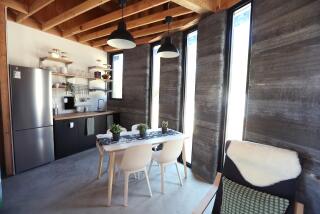Steeling Home : Metal Is Used More in Residences as Wood Prices Rise
MURRIETA, Calif. — Looking for all the world like pieces from a giant Erector Set, galvanized framing gleams against a blue sky as workers assemble one of the first metal-framed tract houses in Southern California.
After decades of using wood to craft their homes, some Southland residential builders are listening to pitches from firms with names like Western Metal Lath and Angelus Metal Systems.
Citing soaring lumber prices and a recession-driven need to assume tighter control over costs, builders are buying the metal fabricators’ line: that metal framing can save them money, insulate them from the wood market’s volatile pricing and result in better-built homes.
Experienced builders say the metal can lop as much as 20% from the cost of framing a so-called production home. That could save a builder $3,000 on a typical 2,000-square-foot tract house--$300,000 in a medium-sized development of 100 homes.
While metal framing has been widely used in commercial and industrial construction for 30 years and is the preferred structural material in many large custom homes, it was found in less than 1% of the 840,000 new homes started in the United States last year.
Environmental and economic concerns, however, have combined to force a change, even as the housing industry is slumping and construction suppliers are being squeezed. Several major builders are leading the experimentation: Arizona’s Del Webb Corp.; Orange County’s Baldwin Co., Shea Homes and Warmington Homes; and Bakersfield-based Coleman Homes.
Coleman, in a joint project with Western Metal Lath of Riverside--one of the West’s largest manufacturers of metal framing--is building a metal-framed luxury home in Murrieta, part of the company’s Corta Bella development of semi-custom homes.
“We started looking at metal from a cost point of view because lumber prices have gone through the roof,” said Larry Smith, vice president of Coleman’s Southern California division.
Steel framing can be erected with less heavy equipment and smaller crews because it is lighter and easier to assemble than wood, Smith said. And steel-framed homes can withstand much higher seismic forces than wood, he said.
In addition, steel-framed homes offer consumers greater protection from fire or termite damage--a quality that has made steel the preferred framing material for home builders in Hawaii, which is plagued by a “super-termite” that seems impervious to pesticides.
About 25% of the homes built in Hawaii this year will be framed in steel, and almost all residential building there will be done with steel framing by the middle of the decade, said Alan MacQuoid, chief executive of Los Angeles-based Angelus Metal Systems, a supplier for the island state’s biggest home builder.
“We think residential steel is the most explosive area in the nation’s steel industry,” he said.
Steel is now used in only about 0.5% of new homes in the United States, MacQuoid said. But he thinks that will jump to 5% of housing starts in the next few years. “Residential framing could be the thing that single-handedly resuscitates the U.S. steel industry,” he said.
Both MacQuoid and Raymond J. Beer, a vice president at Western Metal, expect components for metal-framed houses to account for 90% of their business by 1995, up from less than 10% today.
Even if that kind of growth occurs, metal won’t pose much of a threat to the lumber industry.
“At full production, all of the metal framing companies in the country could probably supply about 10% of the demand” for residential framing components, Beer said.
Still, the steel industry is eager to pursue the potential for growth in any of it business segments.
The American Iron and Steel Institute, a trade association in Washington whose members include major steel manufacturers, set up a committee early last year to adopt metal construction standards for homes.
The committee went to work because officials thought that the residential building industry might be interested, committee director Rick Haws said. That perceived interest has turned into “a flood of demand” since earlier this year, when lumber prices rose to new highs, he said.
As a result, the institute, in conjunction with the National Assn. of Home Builders, provided steel framing for the NAHB Resource Conservation Research House now under construction in Maryland.
Southland builders have been flocking to Murrieta by car and by private plane to walk through the 3,000-square-foot residence that Coleman Homes is building in the hills five miles south of Lake Elsinore.
Kevin Fleming, a vice president of construction, said Newport Beach-based Baldwin’s Co.’s Orange County division is “looking into the feasibility of using metal on two upcoming attached housing projects in Orange County.”
The company’s interest in metal is largely because of the volatile lumber market. “We don’t see it calming down,” said Fleming, noting that environmental problems like the spotted owl controversy in the Northwest and natural disasters like Hurricane Andrew have restricted lumber supplies and driven up costs.
Fleming is among those who see other benefits from steel framing.
“Steel framing lets us build homes with straighter walls and ceilings,” he said, because it doesn’t warp, as much of today’s framing lumber does. “And it’s completely recyclable, so it’s environmentally conscious. Plus there is the possibility of better fire insurance rates for homeowners.”
Baldwin’s studies show that with a metal framing system similar to that being used in the Coleman Homes project, framing costs can be reduced by about 10%.
One big saving with metal, he said, is that there is no waste. Steel beams are made to exact size and do not vary in quality from piece to piece. With wood framing, by contrast, builders typically count on a 15% waste factor to compensate for split and cracked lumber and for leftovers after individual pieces are cut to length.
Some of those savings will likely be erased initially by higher fabrication costs, Fleming said, because building the first homes out of new materials or using new techniques typically adds to construction time. “But if we can break even in net costs,” he said, “then we’ll probably do it.”
Chucking Wood for Metal Citing rising and erratic lumber costs, builders are looking at metal as a substitute for wood in framing houses. The saving can be as much as $3,000 in construction costs on the typical 2,000-square-foot home. A look at fluctuating wood prices in the past 18 months. (Prices are per thousand board feet. A board foot is 12 inches square by one inch thick.) Sources: Random Lengths magazine, Barr Lumber Co.
Steel Comes Home
Steel-framed homes may be the wave of the future. Here is a list of the benefits of using steel instead of wood.
Withstands seismic or earthquake activity better than conventional wood framing
Termite- and vermin-proof
Uses recycled steel made in the U.S.
Does not warp, shrink, twist, bow, split, swell or rust
Non-combustible
Offers more durability, strength and versatility than wood
The material is nontoxic
Visually, steel-frame homes are impossible to distinguish from timber-framed homes
As with wood, metal can use stucco exteriors, drywall interiors and tile roofs
Source: Coleman Homes; National Assn. of Home Builders
More to Read
Inside the business of entertainment
The Wide Shot brings you news, analysis and insights on everything from streaming wars to production — and what it all means for the future.
You may occasionally receive promotional content from the Los Angeles Times.










